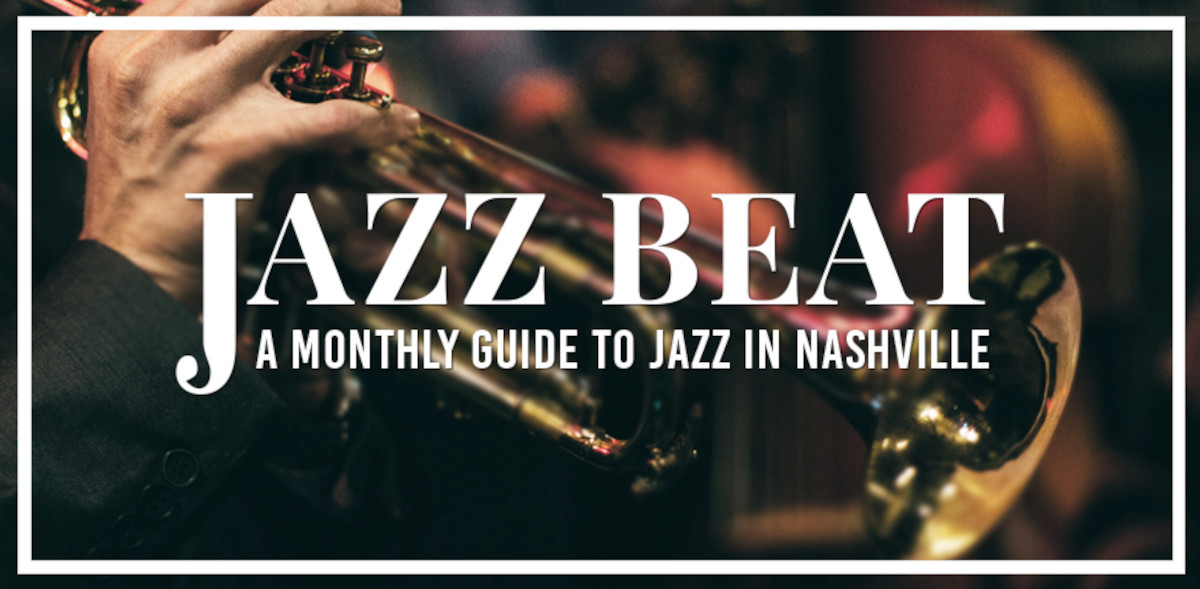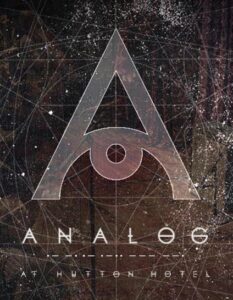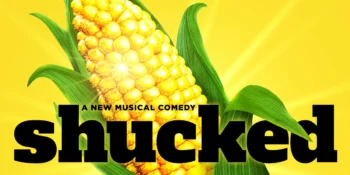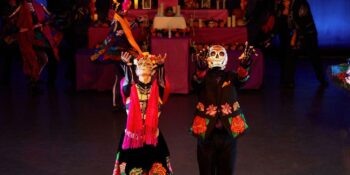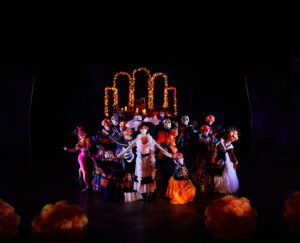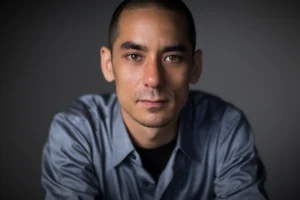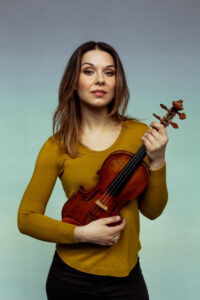From the Nashville Rep.
Our Town at TPAC: “Nice town, y’know what I mean?”
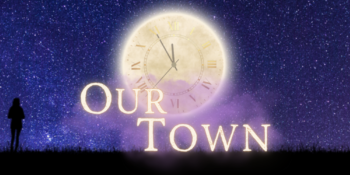
Running from October 25 through November 3 at the Tennessee Performing Arts Center is the Nashville Repertory Theatre’s production of Thornton Wilder’s Our Town. The production is excellent, and it seems to fulfill many of what seem to be Wilder’s intentions in the creation of this diversion.
Our Town was completed in 1938, at the very height of the great depression and with a second global war and catastrophe looming in the political contests in Europe. The third act was written in September of that year, while Wilder was in Munich, a little over a month after the Nazi Luftwaffe had demonstrated their new and devastating Messerschmitt Bf109 fighter there. Within six months, Japan would invade China and Germany would take over Austria. And yet the escapist nature of the play is balanced by its derivative relationship to Charles Dicken’s A Christmas Carol from a century before (complete with ghosts) carrying the same moral lesson that people should appreciate the simple interactions and joys of daily life while they have the chance.
Further, the play is a meta narrative, in that it is a play, or better, an “investigation” set in the actual theater where it is performed with a narrating “stage manager” played handsomely with an incredible grace and authority by Wesley Paine. The stage manager’s character exists somewhere between a narrator and a Greek chorus. She frequently speaks with the audience directly, introduces scene changes and characters, demonstrates empathy and describes background events in the personal lives of the citizens of Wilder’s fictional town—Grover’s Corners New Hampshire, 1901.
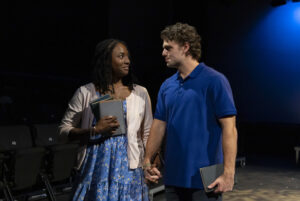
The protagonists, if they can be described that way as there isn’t really an “antagonist,” are the fetching couple Emily Weber (Candace-Omnira) and George Gibbs (Bryce Dunn). Theirs is an all-American love story, complete with tragedy, that draws on your heart. Dunn brought out the innocence and perhaps a bit stupid sincerity of George Gibbs with an eloquent nuance, and Candace-Omnira’s Emily Weber was splendid—her portrayal was a masterclass in expression. Her simple, perpetually untied and slightly anachronistic pair of chucks demands special mention for Melissa Durmon’s costuming, but her sharp wit and growing intellect made one wonder if her character might just take that train to Boston someday.
Mr. and Mrs. Webb, (Bakari King and Katie Bruno) were excellent as the newspaper editor and his wife. King’s goofy common-sense comedy, sort of a proto Ralph Kramden or Cliff Huxtable, was super. Dr. and Mrs. Gibbs (Galen Fott and Erica Elam) were excellent too. Elam gave a remarkable portrayal of a rather difficult nuance—a caring, selfless woman who sacrifices her own dreams for those she loves, a role that corroborated, even as it comforted, in the broader tragedy of the story. Beth Anne Musiker’s Mrs. Soames was just downright hilarious, providing a levity that allowed for the multi-layered (with cynicism and hope) depiction of the wedding to emerge without being overly pedantic.
Despite his efforts at escapism and timeless depiction, the outside world of 21st century Tennessee did find its way onto the stage or at least into my mind. The most obvious interactions were the frequent references in the play to the different churches in Grover’s Corners, which elicited laughter from the audience (especially at the mention of “the Baptists”). Mrs. Gibbs’ description of Dr. Gibbs’ interest in the Civil War (barely 45 years shy of its end in the play) gave the impression that the conflict had long since passed, but at that point the contemporary political (Trump vs. Harris) context hung over the audience like a fearsome cloud.
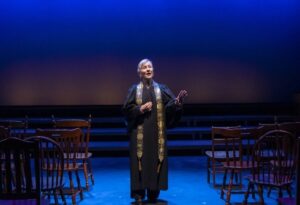
Perhaps most powerful was the Music Teacher, Simon Stimson, played with an appropriately chilling bitterness by Shawn Knight. From the perspective of Wilder’s time, Stimson’s drinking in the first act, his impatience with his singers at the church and his ultimate suicide were all understood as character or even moral flaws. In an age of the Christian Temperance movement this interpretation made sense, but to my eyes, his character pointed to a depressed man who was self-medicating with alcohol. The contrast revealed a side of Grover’s Corners that is closer to Peter Grimes’ Borough than anyplace Norman Rockwell ever drew—a nice town indeed.
Finally, Grovers Corners is largely a blanched community and its only recognized minority population lives in “Polish Town.” Apart from mention of the civil war, explained by Wilder as a time when “New Hampshire boys…had a notion that the Union ought to be kept together, though they’d never seen more than fifty miles of it themselves” there is no mention of racial tensions—this in a play set at the beginning of segregation and Jim Crow in the United States.
In an ingenious gesture, the props in Gary Hoff’s scenic design are first absent particulars (plates, cups, paper, etc), but in the third act they appear as the characters’ perspective changes, and they learn to recognize that there is “something eternal in every one of us.” At that moment I briefly wondered if the characters might not also see the broader and uglier world events that Wilder had excised from his fictional town—the lynchings, the multiple approaching wars, etc.
Ultimately, as I said at the top, the performance was excellent, but in a time (as always) when our society demands participation, Wilder’s escapism left me disconcerted. Works that ask us to recognize the beauty of the everyday rarely explain how that might be accomplished without ignoring the injustices that mark every epoch.
The Jazz Beat, November, 2024
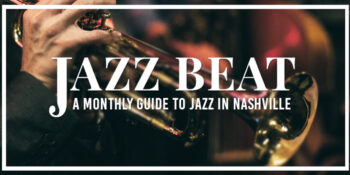
Hello, all, and welcome back to this regular column here at Music City Review. Here, we will update you with the most can’t-miss jazz events happening in Music City, so you can be sure to catch all your favorites, as well as discover new ones along the way. Get out there and support your local musicians and keep Music City thriving! We are always looking to promote great music that may not get the attention it deserves. Have an event you think should be included in the next issue? Email me at: JazzBeat@musiccityreview.com
If you wish to subscribe to this guide, click here! Links to specific venues below:
This Month’s Highlights
Here you’ll find the shows and events this month that I think are the real standouts, unique events that you won’t find every day in the city.
Pigeons Playing Ping Pong – Friday, November 1 – 8:00 PM (Brooklyn Bowl)
PPPP is one of my favorite bands, and although this show is happening the day this newsletter comes out, I will certainly be at the show and I couldn’t help but include it. Featuring highly skilled musicians, the band performs a great blend of rock and funk with plenty of guitar solos to go around. If you can manage to get a ticket, I highly recommend it!
Here Come the Mummies – Saturday, November 2 – 8:00 PM (Brooklyn Bowl)
Amazingly, as the name might suggest, this is a band of mummies. Known for their live performances and funk-rock sound, the band consists of various professional musicians based here in Nashville who all perform anonymously in mummy costumes.
Felix Martin – Sunday, November 10 – 7:00 PM (DRKMTTER)
Venezuelan guitarist Felix Martin is something of an enigma. Blending genres as diverse as metal, jazz, and Latin music while performing on self-designed 12, 14 and 16-string guitars, Martin has performed all over the world, from America to Europe to Latin America to China. Martin now makes a stop in Music City.
Wendy Moten – Thursday, November 14 – 7:00 PM (The Cherry Theater)
Originally from Memphis, jazz singer Wendy Moten now calls Nashville her home. Moten used her powerful vocal abilities to become runner-up on NBC’s The Voice, and since beginning her recording career in 1992 has released five full-length studio albums and amassed almost one hundred thousand monthly listeners on Spotify.
Ari Hoenig Trio (2 sets) – Friday, November 15 – 5:30 PM ($25) & 8:00 PM ($35)
Highly acclaimed jazz drummer, composer, and educator Ari Hoenig drops into Music City for two back-to-back sets at Rudy’s. Hoenig has been studying and performing music since before the age of fourteen, and since has performed with some of the greats of the modern era, including Kenny Werner, Kurt Rosenwinkel, Joshua Redman, and many more. His trio for this performance will feature Jacob Duncan on saxophones and Ryan McGillicuddy on bass.
Sam Greenfield – Thursday, November 21 – 6:30 PM (The Basement)
Saxophonist Sam Greenfield’s music is upbeat, funky, and features intricately written harmonic lines. His sound will hit home for any jazz fan.
Dogs in a Pile – Thursday, November 21 – 7:00 PM (The Basement East)
Blending jazz, funk, rock, and psychedelia, Dogs in a Pile is a band from Asbury Park, New Jersey, continuing the rich musical legacy of that town while forging ahead with their own original sound.
James Austin Jr. Trio “Songs in the Key of Wonder and More!” – Friday, November 22 – 8:00 PM ($20)
Chicago-based James Austin Jr is an accomplished jazz pianist and bandleader who has studied under the tutelage of a number of legendary jazz musicians, including extensive study with Barry Harris. “Songs in the Key of Wonder” is a special project of Austin’s unique jazz arrangements of a collection of a beloved Stevie Wonder tunes.
Ari and Cecil Alexander Quartet – Friday, November 29 – 8:00 PM ($23)
Eclectic musical duo Ari and Cecil Alexander will perform a selection of originals and Great American Songbook classics, arranged for an intimate yet energetic quartet setting. Both leaders are highly accomplished musicians and composers. Cecil Alexander is a guitarist from Michigan who has won numerous guitar competitions, while Ari Alexander is a Danish-American vocalist who comes from a long line of musicians.
Analog at Hutton Hotel
Analog Soul (multiple shows) – Sundays, November 10, 17, & 24 – 7:00 PM (Free GA / $20 reserved seating)
The Analog continues its Analog Soul series, featuring some of the city’s most promising emerging talent who are redefining soul music. The performance on the 17th will feature Analog regulars Will Davenport, Alex Slay, and Jon “DJ Smoke” Lucas, while artist for the other two shows are still To-Be-Announced.
Arrington Vineyards
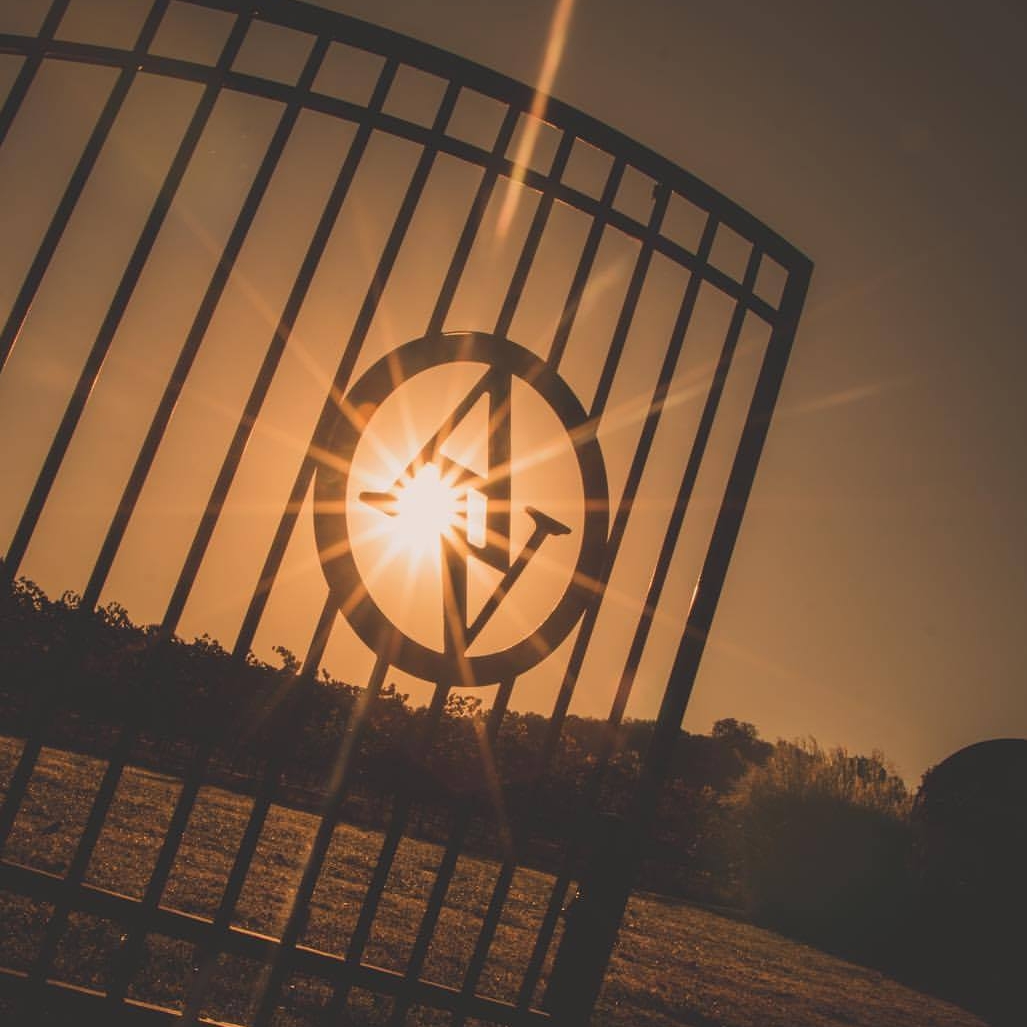
Music in the Vines Series – Every Saturday (3:00-7:00 PM) & Sunday (1:00-5:00 PM)
Arrington Vineyards features concerts of Jazz and Bluegrass every Saturday and Sunday. Below is listed the lineup for this month.
- Saturday, November 2 – The Lilliston Effect Sunday,
- November 3 – The Miles Damas Group Saturday,
- November 9 – Art Four Sale Band Sunday,
- November 10 – Reed Pittman Band Saturday,
- November 16 – 9 Volt Romeo Band Sunday,
- November 17 – The Josh Karas Trio Saturday,
- November 23 – The Miles Damas Group Sunday,
- November 24 – Reed Pittman Band Saturday,
- November 30 – The Lilliston Effect
Live Jazz on the Hillside – Every Friday (except Black Friday) (3:00-7:00 PM)
This month Arrington will also feature a series of dedicated jazz concerts on Fridays on the Hillside Stage. Below is listed the lineup for this series.
- Friday, November 1 – The Josh Karas Trio
- Friday, November 8 – Andrew Carney and the Essentials
- Friday, November 15 – The Lilliston Effect
- Friday, November 22 – Andrew Carney and the Essentials
Black Friday Food Trucks & Jazz – Friday, November 29 – 12:00 PM
Food Truck Friday at Arrington returns for Black Friday, featuring food trucks Mac Shack and Cousins Maine Lobster, and live jazz from 9 Volt Romeo.
City Winery Nashville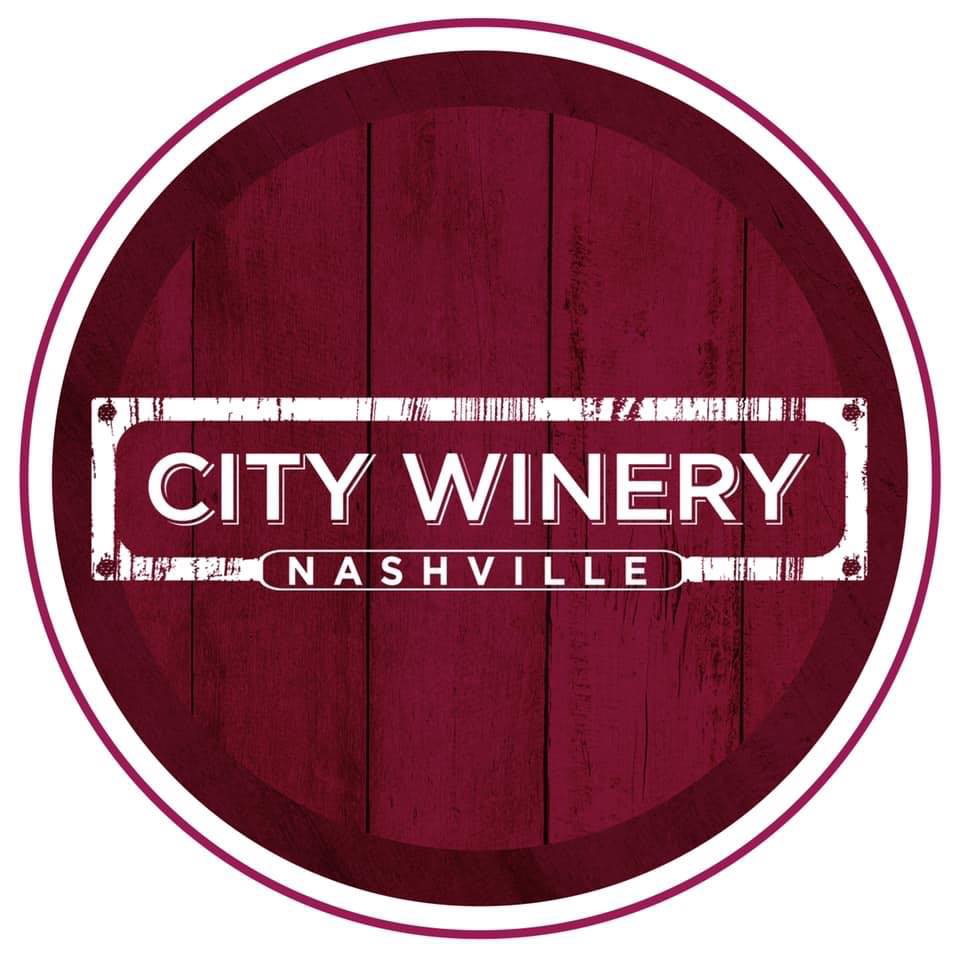
Nashville’s City Winery is a beautiful venue that consistently features top-talent acts that span genres from Jazz to Americana to Hip Hop. The below performances showcase a mix of several genres, but will certainly be of interest to any jazz audience. Enjoy these concerts accompanied by a stellar selection of wine and delicious bites.
Main Stage
Jeff Bradshaw – Thursday, November 7 – 7:30 PM ($35+)
Jazz-soul trombonist Jeff Bradshaw has returned to the scene after a six-year hiatus from performing. His last album, Stronger, was released in November of 2020 and features industry giants like Grammy-winners Robert Glasper, Raheem DeVaughn, and Marsha Ambrosius. The album was nominated for a 2021 NAACP Image Award.
The Nashville Jazz Workshop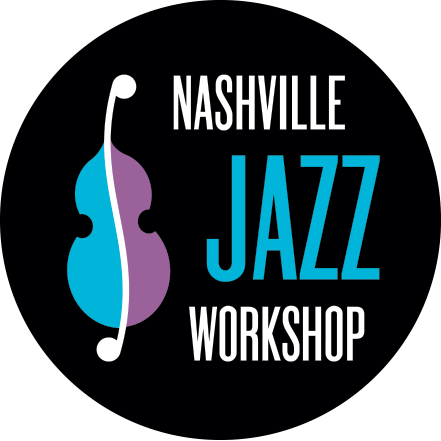
Moving on to Music City’s other great jazz venue, the Jazz Cave at the NJW is a venue with world-class acoustics, which consistently ranks in Downbeat Magazine’s list of Great Jazz Venues in the world. Tickets can be purchased through the Workshop website.
Jazz Cave
Thea Danos Presents ‘Tis Autumn – Friday, November 1 – 7:30 PM
In-demand Nashville jazz vocalist Thea Danos performs a fall-themed set with her backing trio in the Jazz Cave. This special performance will pay homage to jazz greats like Nat King Cole and Ella Fitzgerald, and feature classics from the Great American Songbook like “’Tis Autumn,” “Autumn Leaves,” “Early Autumn,” “Autumn in New York,” and many more. Her backing band features Alex Murphy on piano, Baily Johnstone on bass, and Ryan Brasley on drums.
Lori Mechem Quartet – Saturday, November 2 – 7:30 PM
Longtime Nashville pianist, composer and educator Lori Mechem performs with her quartet. Mechem’s career directing countless productions and performing with greats like Jimmy Smith and Dizzy Gillespie have earned a highly respected name in the industry. Her quartet will feature her husband Roger Spencer on bass, Andy Reiss on guitar, and Larry Aberman on drums.
The Jordan Perlson Trio – Friday, November 8 – 7:30 PM
Prominent Nashville drummer Jordan Perlson comes to the Cave with his trio featuring pianist David Rogers and bassist Jacob Jezioro. Perlson’s career has encompassed over one hundred recording credits and performances with artists as varied as Gary Burton, Missy Raines, Matisyahu, Snarky Puppy, Kaki King, and many more.
Level Up Big Band: Stage One – Sunday, November 10 – 7:30 PM
The Level Up Big Band is a 17-piece ensemble dedicated to performing music from hit video games. It may sound silly, but this band features some of Nashville’s top jazz talent, including Jeff Coffin, Jamey Simmons, Kevin Gatzke, Brandon Moore, and many others.
Alex Graham’s Psychedelic Doomsday Machine – Friday, November 15 – 7:30 PM
Alex Graham is one of Nashville’s preeminent alto saxophonists, composers, and educators. For this special performance, he returns to the Cave with some of Nashville’s other great musicians to perform Alex’s genre-bending music, featuring new arrangements and compositions. His band will feature Emmanuel Echem (trumpet), David Rodgers (rhodes), Brian Allen (bass), and Marcus Finnie (drums).
Rudy’s Jazz Room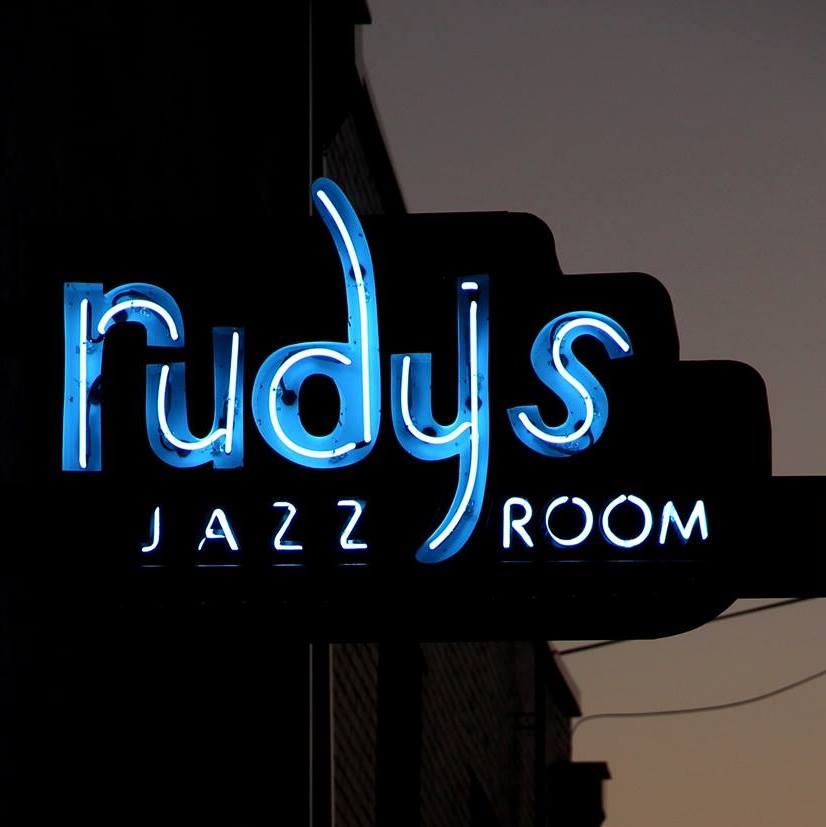
And now we move on to Nashville’s premier jazz club, with its cozy, intimate setting. I’ll start with some of the unique highlights for this month, then follow up with the great regular acts performing. Please note that some shows are one dollar cheaper if you purchase advance tickets. I have listed the door price for all shows.
Rudy’s Highlights
Below are the performances for this month that I’ve picked out as the real can’t-miss shows, some featuring touring artists from out of state, others featuring local artists giving specialized, unique performances. Below are the performances for this month that I’ve picked out as the real can’t-miss shows, some featuring touring artists from out of state, others featuring local artists giving specialized, unique performances.
Lisa Stewart – The Legends of Jazz: A Tribute – Friday, November 1 – 5:30 PM ($15)
Acclaimed jazz singer Lisa Stewart performs with an all-star band featuring drummer Chester Thompson, pianist Jeff Taylor, bassist Jack Aylor, and trumpeter Michael Fair. This special performance pays tribute to the all-time greats of jazz vocal music, featuring classics by Billie Holiday, Ella Fitzgerald, and more.
Sofia Goodman Trio – Friday, November 1 – 11:00 PM ($10)
Award-winning Nashville-based drummer and composer Sofia Goodman returns to the Rudy’s stage. Her music has been highly praised by publications like DownBeat magazine, as well as industry titans like Jeff Coffin.
Don Aliquo / Miguel Alvarado Quintet – Saturday, November 2 – 8:00 PM ($21)
Renowned Nashville saxophonists Don Aliquo and Miguel Alvarado co-lead a quartet featuring Rob Linton on bass and Dave Potter on drums.
Marc Payne (2 performances) – Saturday, November 2 – 11:00 PM ($10) & Monday, November 11 – 6:00 PM ($12)
One of Nashville’s most talented up-and-coming pianists Marc Payne will lead his trio. Payne has been praised for his diversity and wide knowledge of many jazz styles. He has spent his life in Nashville soaking up many different sounds and styles, and this diversity comes through in his masterful playing. The first of these performances will be in quartet format, featuring Rob Linton (bass), Nate Spratford (sax), and Christian Burgs (drums), while the second will feature his regular trio.
Jerome Degey Jazz Quartet – Sunday, November 3 – 6:00 PM ($14)
Degey is a Nashville-based guitarist originally from Paris, France. His family heritage also features Afro-Caribbean roots, and together with his longtime interest and study of Brazilian culture, these influences create a rather unique musical blend. His regular trio features Ryan Brasley on drums and Charles Treadway on keys, but for this performance they will also be joined by Don Aliquo on saxophone.
Blue Matter Project ft. Robert Baglione – Monday, November 4 – 6:00 PM ($12)
Chicago native guitarist Robert Baglione and his band Blue Matter Project offer interpretations of straight ahead contemporary electric and pop jazz stands. The band will feature Anthony Belfiglio on keys, Brian Cornish on sax, Leland Nelson on bass, and Isaac Velasquez on drums.
Crystal & Friends – Wednesday, November 6 – 6:00 PM ($12)
Soulful jazz vocalist Crystal Miller returns to the Rudy’s stage once again to offer her moving interpretations of classic music.
Basher – Wednesday, November 6 – 9:00 PM ($15)
Basher is a New Orleans-based “free jazz party band,” offering performances of highly improvisational music. Led by saxophonist and composer Byron Asher, the band has been performing across the US since 2017, and have garnered much attention in the New Orleans creative music scene. This should be a great show for anyone interested in the more progressive side of jazz music.
Bruce Dudley Quartet Plays the Music of Cedar Walton – Thursday, November 7 – 9:00 PM ($14)
Bruce Dudley is a Steinway Concert Artist who has over 40 years of experience performing jazz all throughout North and South America. He has recorded a number of albums as bandleader, as well as performed with big industry names like Aretha Franklin, Herb Ellis, and Crystal Gale. This special performance will pay tribute to the music of jazz great Cedar Walton, and the quartet will feature Don Aliquo, Rob Linton, and Ryan Brasley.
The Chris Mondak Band – Friday, November 8 – 11:00 PM ($10)
Nashville bassist and composer Chris Mondak returns to the Rudy’s stage with his band. Mondak’s aggressive bass style has been compared to that of legendary bassist Charles Mingus, and he has performed extensively throughout the US, as well as in Australia, Mexico, and Panama.
Andy Reiss & Joe Settlemires – Saturday, November 9 – 5:30 PM ($15)
Two of the top guitarists on the scene today come together for an evening set of guitar-duo jazz. Andy Reiss is a known face on the Rudy’s stage, having been performing in Nashville for decades, while Joe Settlemires hails from Oklahoma, where he is one of the state’s most prolific and celebrated musicians.
Jose Gobbo Quartet ft. Marc Payne – Saturday, November 9 – 11:00 PM ($12)
Jose Gobbo is a Brazilian jazz guitarist now based in Illinois. He has performed all over the US and been featured as a guest artist at a number of prominent universities. He now performs with a quartet featuring Marc Payne on piano, Bailey Johnston on bass, and Jay Ferguson on drums.
Nigel Cathéy Quartet “Standards Sessions” – Wednesday, November 13 – 6:00 PM ($12)
Known for his curation of an authentic, vibrant live performance, Nashville trumpeter, arranger, and educator Nigel Cathéy offers a collection of jazz standards in a quartet format, featuring the works of Tadd Dameron, Cole Porter, and Miles Davis.
Ari Hoenig Trio (2 sets) – detailed above
The Ted Ludwig Quartet – Saturday, November 16 – 8:00 PM ($20)
Highly acclaimed New Orleans seven-string guitarist Ted Ludwig performs with his quartet.
Wendy Burns Sings the Great American Songbook – Sunday, November 17 – 6:00 PM ($18)
Nashville vocalist and flutist and host of Rudy’s semi-regular Ladies of Jazz series Wendy Burns presents and evening of all the most classic jazz tunes from the Great American Songbook. Having studied this music literally her entire life, Burns offers expert interpretations of the most timeless jazz music, including works by Cole Porter, George Gershwin, Johnny Mercer, among many others.
Viktor Krauss – Monday, November 18 – 6:00 PM ($10)
Viktor Krauss is a bassist that has called Nashville home since 1992, and has over 600 credits to his name as either bassist, composer, or producer.
Rebecca Carlson – Thursday, November 21 – 9:00 PM ($14)
Jazz and blues vocalist Rebecca Carlson has made a name for herself across the country, taking stints based in New York City, Tucson, Los Angeles, and now Nashville. An extensive touring and recording career has made her quite an in-demand performer.
James Austin Jr. Trio “Songs in the Key of Wonder and More!” – detailed above
Andrew Golden’s Farm Feelings – Friday, November 22 – 11:00 PM ($12)
Nashville trumpetist Andrew Golden, host of the weekly Bohemia After Dark jazz show over at Old Glory, and his band Farm Feelings present a rather unique farm-themed performance. Infused with soulful melodies and foot-tapping rhythms, the band’s farm-inspired tunes offer a whimsical and light-hearted evening of music. The band features Ty Bailie on Hammond organ, Adam Mcphail on guitar, and Nate Felty on drums.
Bob Sabellico “Soul Jazz & Jam” – Friday, November 29 – 5:30 PM ($14)
Guitarist, synthesist, and composer Bob Sabellico presents a high-energy jazz jam featuring Jody Nardone on piano, Vail Johnson on bass, and Raymond Massie on drums.
Ari and Cecil Alexander Quartet – detailed above
Rudy’s Regulars
Pat Coil’s “Music for Humans” – Friday, November 1 – 8:00 PM ($21)
Renowned Nashville pianist Pat Coil will perform this month with his special act Music for Humans, which will feature Don Aliquo on saxophone, Wes Little on drums, Adam Nitti on bass, and Hunter Strasser on guitar.
Jonathan Wires Quintet – Saturday, November 2 – 5:30 PM ($15)
Nashville bassist Jonathan Wires returns as bandleader in a quartet setting.
Dana Robbins Quintet – Friday, November 8 – 5:30 PM ($15)
GRAMMY-winning saxophonist Dana Robbins pays tribute to the Soul Jazz sound of the late 60’s and early 70’s, celebrating artists such as Les McCann, Eddie Harris, Jimmy Smith, and more. Robbins has either recorded or performed with many artists, including Keb’ Mo’, Aretha Franklin, Taj Mahal, Keith Urban, and more. Her band features David Santos (bass), Wes Little (drums), Phil Hughley (guitar), and Darius Mines (piano/B3 organ).
Stephanie Adlington – Friday, November 8 – 8:00 PM ($23)
Another frequent visitor to the Rudy’s stage, award-winning vocalist, songwriter and vocal coach Stephanie Adlington is known as the “Siren of the South,” with an “unrivaled” take on the Great American Songbook.
Jody Nardone Trio (2 performances) – Saturday, November 9 ($22) – 8:00 PM & Saturday, November 23 – 5:30 PM ($17)
Prominent Nashville pianist Jody Nardone brings his trio to Rudy’s for a classic jazz set. With a growing national reputation, Nardone seamlessly shifts from the “whispered beauty of Bill Evans to the percussive flights of McCoy Tyner.” (Michael McCall, Nashville Scene)
Sully’s Swingin’ Sunday Supper – Sundays, November 10 & 24 – 6:00 PM ($12)
Every other Sunday, Rudy’s features a Sunday dinner, with one of Music City’s top bassists Jimmy Sullivan leading a swingin’ jazz band featuring rotating special guests, for which a unique dinner special is served just for the show.
Regi Wooten & Friends – Wednesdays, November 13, 20 & 27 – 9:00 PM ($15)
Coming from a distinctly talented musical family, Regi Wooten is one of the most innovative and dynamic musicians on the scene today, pushing the boundaries of the traditional genres. Equally at home playing Hendrix as Wes Montgomery, Wooten assembles a group of some of Nashville’s best musicians to offer a night steeped in funk, jazz, soul, blues and rock.
Cliff Richmond & the CliffNotes – Thursday, November 14 – 9:00 PM ($14)
Guitarist and vocalist Cliff Richmond’s band always features some of Nashville’s top talent, and presents a great blend of soulful, swinging, and funky jazz.
Don Aliquo Trio (multiple performances) – Friday, November 15 – 11:00 PM ($10) & Saturday, November 23 – 11:00 PM ($10)
One of Nashville’s most active and accomplished saxophonists, Aliquo will be leading performances with his trio twice this month.
Pat Coil Quartet – Saturday, November 16 – 5:30 PM ($16)
Renowned Nashville pianist Pat Coil will lead his quartet featuring Pat Bergeson on guitar, Baily Johnstone on bass, and Ryan Brasley on drums.
Geoff Pfeifer Quartet (2 performances) – Saturday, November 16 & Friday, November 29 – 11:00 PM ($10)
Playing a mix of Wayne Shorter tunes and originals, Geoff Pfeifer brings gritty, edgy, genuine NYC-style jazz to Rudy’s stage with his Quartet.
Bizz Bigsby – Wednesday, November 20 – 6:00 PM ($15)
Nashville native Bizz Bigsby shares his very personal music which tells the story of his life, influenced by everyone from Bill Withers to George Jones to James Taylor.
Bruce Dudley Quartet – Saturday, November 23 – 8:00 PM ($21)
Bruce Dudley is a Steinway Concert Artist who has over 40 years of experience performing jazz all throughout North and South America. He has recorded a number of albums as bandleader, as well as performed with big industry names like Aretha Franklin, Herb Ellis, and Crystal Gale. This performance will feature a quartet format with Monica Ramey on vocals as well as Roger Spencer on bass and Larry Aberman on drums.
Re-Evolution – Monday, November 25 – 6:00 PM ($12)
This five-piece band is heavily influenced by classic jazz cutting-edge artists like Thelonius Monk, Wes Montgomery, John Coltrane, Bill Evans, and more. The band consists of Brian Cornish on saxophone, Regi Wooten on bass, Daryl Johnson on drums, Adam Charney on guitar and Alex Murphy on piano.
PT Gazell & The Side Effects – Wednesday, November 27 – 6:00 PM ($10)
Giovanni Rodriguez & 12 Manos – Every Monday – 9:00 PM ($15)
A favorite on the Nashville Latin and jazz scene, multi-instrumentalist Giovanni Rodriguez presents an electric night of salsa, along with his band consisting of Rodriguez (bass/vocals), Melvin Macias (piano/vocals), Jesus Agreda (Timbales), Lorenzo Molina Ruiz (Trumpet), and Manuel ‘Manotas’ Ramierez (multi-Percussion).
Hot Club Gypsy Jazz – Every Thursday (except Thanksgiving, November 28) – 6:00 PM ($12)
Every Thursday night, Rudy’s honors its New Orleans and French roots by celebrating the vibrant music of Gypsy Jazz. These nights feature a variety of small groups either led or curated by New Orleans native Brook Sutton, all performing music in the style of the great Django Reinhardt and Stephane Grapelli. The bar will feature French Quarter-inspired cocktails as well as gumbo and beignets. Come out for as authentic a night as you can get without a trip to the French Quarter.
Rudy’s Jazz Jam – Every Sunday – 9:00 PM ($10)
I couldn’t make a list of Rudy’s events without including a shout-out for the regular weekly Jazz Jam the club hosts every Sunday night. Whether you are a jazz musician and you want to jam with your fellow artists, or you just want to come and enjoy what the local talent has to offer, the Jazz Jam is a great way to end your weekend.
Sambuca Restaurant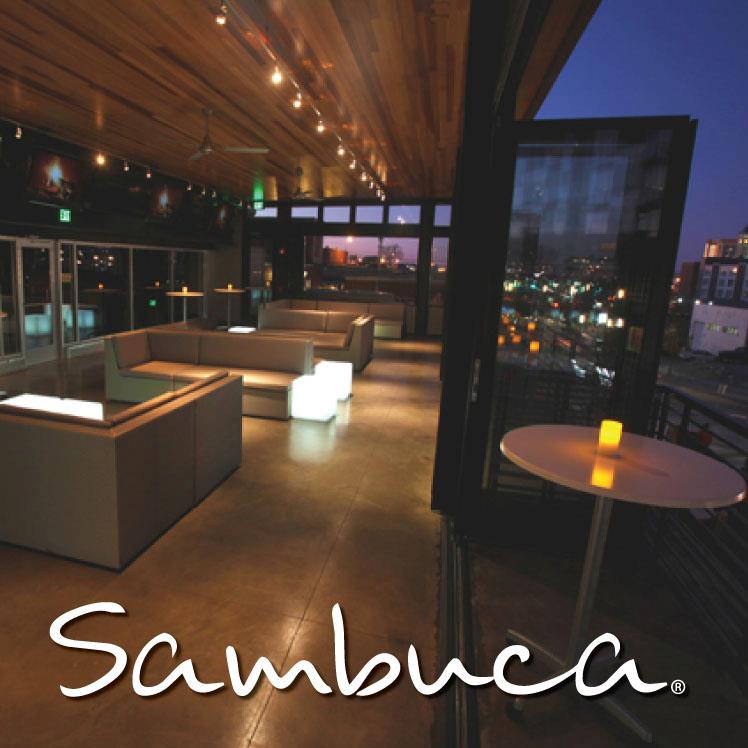
Sambuca is a New American restaurant in Nashville’s Gulch district, featuring nightly live music. Below are the appearances that will interest the jazz listener!
Patton James – Wednesday, November 6 – 6:00 PM
Guitarist and singer/songwriter Patton James presents his selection of original music and works from the American Songbook.
Amanda Raye – Thursday, November 7 – 6:00 PM
Though her music stands out as a blend of soul and country, singer Amanda Raye has been noted for her jazz influences.
Erik Blue – Friday, November 8 – 7:00 PM
This band has been described as “the best live band in Nashville,” creating an upbeat atmosphere that keeps audiences on their feet.
Stephanie Adlington – Sunday, November 10 – 6:00 PM
Detailed in the Rudy’s section above, Adlington is a jazz vocal mainstay in Nashville.
Cliff Richmond – Tuesday, November 12 – 6:00 PM
Nashville guitarist and Rudy’s regular Cliff Richmond will perform once this month.
Leif Shires – Thursday, November 14 – 6:00 PM
Modern jazz trumpeter Leif Shires will perform once this month. Shires, who has performed with many artists including Tom Jones, the Secret Sisters, Kelly Lang, and many others, now presents a traditional, straight-ahead jazz sound that is sure to be a great accompaniment to a delicious meal.
Steve Roper – Sunday, November 17 – 6:00 PM
For three years, Steve Roper was the band leader and music director for the Steven Roper and the B.B. King Allstars band at the B.B. King Club here in Music City. His primary genres are jazz and blues, but his skillset extends well beyond these styles to R&B and even country.
Dinner Over Jazz Series – Monday, November 18 – 7:00 PM
Sambuca’s Dinner Over Jazz series continues, this time featuring Lindsey Webster.
Sarah J – Tuesday, November 19 – 6:00 PM
Known for an energetic personality and audience interactions, Sarah J’s music combines R&B, pop, and contemporary jazz.
Ben Graves – Monday, November 25 – 6:00 PM
An incredibly eclectic and versatile musician, Ben Graves has performed music in genres from classical to jazz to hard rock, weaving all of this experience together into a unique style.
The Underdog Nashville
The Guthrie Trapp Trio – Mondays, November 4, 11, & 25 ($10)
One of Nashville’s preeminent guitar talents will perform several times at the Underdog. More blues and country than jazz, Trapp’s intricate and highly technical guitar playing will surely interest those who love the technicality of jazz music. His trio features Jordan Perlson on drums and Tim Marks on bass.
Hank Born – Tuesday, November 26 – 8:00 PM (Free)
Nashville-based guitarist Hank Born returns to the Underdog for his monthly residency. Born’s playing combines elements from influences like Herbie Hancock and George Benson, making this a can’t-miss performance for any modern jazz fan.
University Jazz
As the academic semester winds down this month, naturally there is a plethora of student recitals at the city’s music schools. I’ve listed the ones of interest below.
Vanderbilt – Blair School of Music 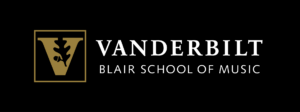
Vanderbilt Jazz Orchestra and Blair Jazz Choir – Sunday, November 10 – 8:00 PM (Free w/ Tickets Required)
Blair Big Band – Thursday, November 14 – 8:00 PM (“Pay As You Wish” – $0-30)
Blair Jazz Combos – Sunday, November 17 – 8:00 PM (Free w/ Tickets Required)
Belmont 
Jazzmin – Friday, November 1 – 6:00 PM
Jazzmin is a jazz vocal group performing a range of styles from blues to swing to bebop to contemporary.
Jazz String Septet – Sunday, November 10 – 6:30 PM
Faculty Jazz Group – Wednesday, November 13 – 7:30 PM
Regular Nashville Hangs
Bohemia After Dark: Live Jazz Band with Andrew Golden – Every Monday – 8:00 PM (Old Glory)
Tuesday Bluesday w/ Shantelle & The Juke Joint Band – Every Tuesday – 6:30 PM (Rawhides)
Weekly blues night with a different special guest each week.
Dinner & A Show – Live Jazz Band – Every Friday – 7:00 PM (Flamingo Cocktail Club)
Living Room Sessions – Every Friday & Saturday – 8:00 PM (W Nashville Hotel)
Regular weekly showcase featuring local indie, jazz, funk, and R&B bands.
Eastside Jam – Every Sunday – 9:00 PM (Inglewood Lounge)
This is not a traditional jazz jam playing standards, but rather an improv jam, but any jazz player or listener will still be interested!
Nightly Jazz at Skull’s Rainbow Room
The MCR Interview
Percussionist Shane Shanahan on his work with the Silkroad Ensemble
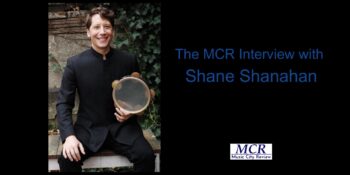
Christina Vongsiharath conducts an interview of percussionist, world musician and member of the Silkroad Ensemble Shane Shanahan. His influences and compositional process are discussed as well as the ensemble’s recent work on the American Railroad project and the coming appearance in Nashville.
Nuevo de Music City
No Es Danza Macabra, Es Ballet Con Identidad
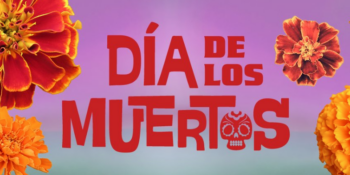
(English Version here)
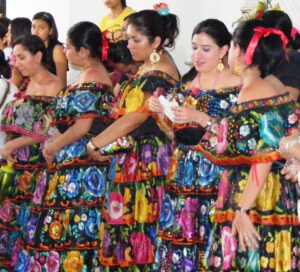
Cuán afortunados son aquellos en quienes sus recuerdos se revelan con nitidez y movimiento. Aún más afortunado es el que es capaz de replicarlos para que permanezcan en la memoria colectiva. Mi maestro de guitarra me decía “Si lograste ver dos ligeras bailarinas danzar, mi interpretación habrá cumplido su propósito.” Ese mismo propósito que inspira los trazos de un artista y los versos del compositor. Ese deseo ambicioso de hacer palpable la imaginación. Y esas bailarinas no son solo un espectro de su creador; su danza es recíproca y transforma la materialidad en movimiento. Los pasos convierten la retórica en un objeto tridimensional, más sin embargo, el espectador conserva la autonomía en su interpretación. En ese instante la remembranza cumple un ciclo impregnando la escena con la historia de cada individuo. Tras bambalinas, sobre el escenario y en las butacas, se ha bordado un tapiz en homenaje a la memoria. Lúcido y lleno de flores como los trajes chiapanecos.
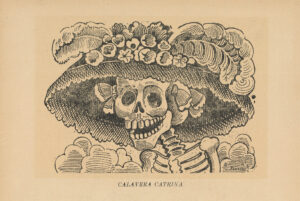
Desde los prolijos arabescos de las máscaras hasta el sentido altar como centro de la escenografía, Día De Los Muertos es un montaje que se destaca por el cuidado de los detalles. La esencia de esta tradición narrada a través de la inspiración artística de Diego Rivera, Frida Kahlo, Carlos Chávez y Lola Álvarez Bravo inicia como un gran acierto en la creación del guion. La incorporación de elementos folklóricos como los mariachis y los alebrijes junto con las figuras místicas de La Catrina y La Bruja, le dieron un toque mágico a la historia. Maria Konrad y el equipo artístico y de producción honraron con elegancia y emotividad la cultura mexicana.
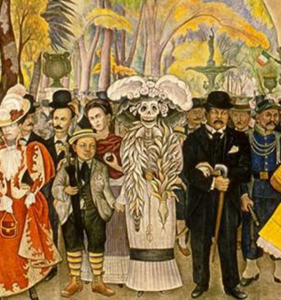
Se me escaparán muchos elementos, así que ya pueden hacerse una idea de la abundancia creativa en este show. Comenzaré por La Catrina al ser uno de los ejes principales no solo en el montaje sino en su significado para la tradición mexicana. Si bien este personaje está inspirado en la versión de Diego Rivera en su célebre obra “Sueño de una Tarde Dominical en la Alameda Central”, la figura se basa en La Calavera Garbancera del también artista mexicano José Guadalupe Posada. La ilustración es una crítica a los indígenas vendedores de garbanzo que menospreciaban sus orígenes y aparentaban una posición social superior. “En los huesos, pero con sombrero francés con plumas de avestruz” la describió Posada. En la obra de Rivera, el personaje aparece de cuerpo completo con un traje acorde al característico sombrero, pero con detalles mesoamericanos como la bufanda en forma de Quetzalcóatl (serpiente emplumada). Rivera le da un lugar especial entre las 150 figuras que se incluyeron en esta obra magna. La Catrina, como el artista la renombró, representa a cada ser humano que, despojado de su apariencia, comparte con sus semejantes la misma estructura y el mismo final.
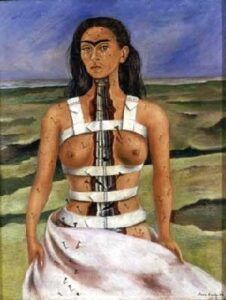
Entre los diferentes estilos de danza que se incluyeron en el montaje, La Catrina tomó ventaja de la técnica de punta del ballet clásico para representar su naturaleza estilizada. Además de eso, sus pasos eran lo suficientemente sonoros para reforzar la cualidad “idiofónica” de sus huesos. El personaje aparece estampado en un lienzo durante el proceso de su creación en lo que podría imaginarse como el estudio de Rivera. Allí el pintor comparte su pasión artística con Frida Kahlo mientras da unas últimas pinceladas hasta convertir la figura en una bailarina que se une con sus movimientos al romanticismo de la escena.
El traje de Frida Kahlo estuvo también inspirado en una pieza de arte, su autorretrato “La columna rota”. Esta pintura representa la fortaleza de su cuerpo y de su alma al mantenerse en pie a pesar de haber sufrido un accidente prácticamente mortal. Las flores bordadas en su falda fueron replicadas en el traje de Rivera reforzando el vínculo de la pareja. La interacción de sus movimientos era cómplice y prolongada, fluyendo en perfecta armonía. En las siguientes escenas se une el compositor Carlos Chávez con un aire de feria, movimientos torpes y zafados que me recordaron al reconocido actor de comedia Cantinflas. La fotógrafa Lola Álvarez Bravo, en contraposición, es ligera, flexible y llena cada espacio del escenario mientras obtiene las mejores capturas con su cámara. A esta celebración de la vida y de la amistad entre los artistas, se une el grupo de mariachis y las bailarinas folklóricas. Los pasos son una mixtura de jarabe tapatío y danza moderna.
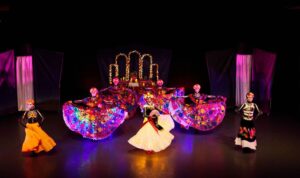
La selección musical de este ballet es otro gran acierto; incorpora la música tradicional y mariachi con lapsos de electrónica. El paisaje sonoro se torna también cinematográfico con las propuestas modernas de Gustavo Santaolalla y el dueto de guitarristas Rodrigo y Gabriela. El plano terrenal parece ser lo suficientemente fantástico, sin embargo, el altar en la escenografía actúa como el portal que nos guiará hacia el mundo de la eternidad. Encontré muy hermosa la sección en la que los bailarines representan cada uno de los gustos de la persona que se está honrando. Uno de ellos ejecuta hábiles ‘toques’ con el balón de fútbol para luego sumarlo a las ofrendas del altar. Entre estos objetos se encuentran también los ‘alebrijes’, guardianes espirituales de naturaleza zoomorfa cuyo propósito es el de guiar la travesía del alma. Estos seres mágicos se transforman en bailarines de colores y personalidades diversas, representando las cualidades que hacen único e irrepetible a cada mortal.
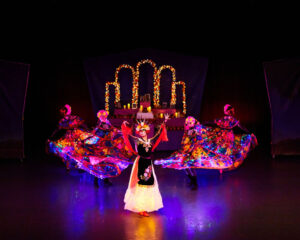
En unión con la celebración del Día de Los Muertos y la música se engendra el último personaje del elenco, La Bruja. La canción en son popular jarocho y que lleva el mismo nombre, se ha convertido en el himno de esta fiesta popular. La letra se inspira en la leyenda de una seductora mujer que preserva su corporeidad bebiendo sangre de niños y de adultos. El clímax del ballet se consolida en esta escena donde cada uno de los personajes interactúa con La Bruja y la subjetividad de la muerte. La escenografía se torna oscura y las faldas tradicionales emanan luces de colores consiguiendo un efecto supremo con los movimientos de la danza. El traje de La Bruja se enciende también, y cuando la bailarina extiende el amplio tamaño de la falda se revela un brillante cúmulo de estrellas. Este momento de fantasía y emotividad captura ingeniosamente la noche del primero de noviembre en el que las calles se revisten de candelas.
El montaje concluye con un racimo de voces superpuestas que mencionan los nombres y el vínculo con aquellos seres que permanecen en la memoria de cada persona. Los bailarines van dando fin a sus movimientos mientras se ubican en una especie de retrato que evoca nuevamente la obra muralista de Diego Rivera. Este cuadro final no se compone solamente por los artistas en escena, sino por artesanos, músicos, diseñadores y técnicos de una creatividad insaciable y un compromiso con el arte, la cultura y la remembranza humana como esencia de nuestra existencia.
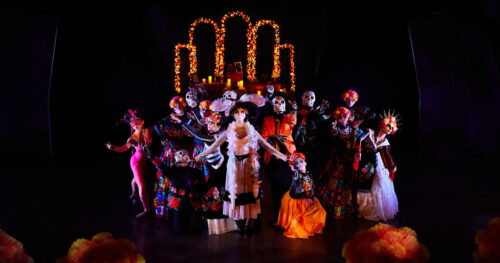
From Our Far-flung Correspondents Series:
Jubilee the Opera
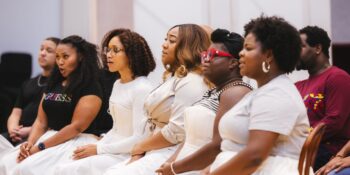
Jubilee the Opera tells the rich history and story of the original Fisk Jubilee Singers. From the conception of the group to their tours across the globe to save their institution from financial ruin, the opera shows the viewer how black students from Nashville, Tennessee, triumphed through trials and tribulations, during the era of reconstruction.

There was a minimalist approach to staging and costumes. This approach not only allows the viewer to focus on the story, but it also foreshadows that their greatest possessions were not materials. Rather it was their relationship to their beautiful melodies. Tazewell Thompson, the director, did a wonderful job intertwining the concert spiritual into the storyline of the opera.
Technically, this body of work was presented like in opera. However, there were moments where it felt as if I was watching a musical. The role of Ella Sheppard, which was portrayed beautifully by Lisa Arrindell, also plays a southern white women, Queen Victoria, and George L. White. As these characters are introduced in the story they are speaking, and the ensemble is reacting. (See interview here) Historically, in opera if the librettist wants to bring out words they use recitatives. Understanding the backgrounds of Tazewell Thompson and Lisa Arrindell, I believe that for this body of work, they made the correct stylistic choice.
It was rather refreshing to see how the humanity of each individual was portrayed. Tazewell Thompson developed the plot of the story by introducing a love affair between two of the singers. While it did intensify the drama of the story line, it seemed misplaced due to a lack of a resolution. Understanding Ella Sheppard’s role with the ensemble, I wish I would have since her developed more. Taze did a wonderful a portraying her as a mother figure and educator, however there were time in which she accompanied the group on piano.
In telling the story of the original Fisk Jubilee Singers, Tazewell Thompson and the entire cast did a wonderful job of introducing the world to one of Nashville’s gems. This body of work is imperative in the rejuvenation and continuation of canon of concert spirituals.
From the Circle Players
For Colored Girls Who Have Considered Suicide/When the Rainbow is Enuf
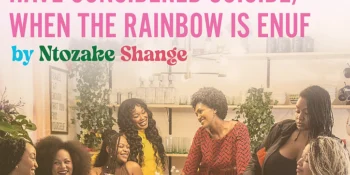
Ntozake Shange’s acclaimed 1976 choreopoem For Colored Girls Who Have Considered Suicide/When the Rainbow is Enuf opened Circle Players’ 75th season. Middle Tennessee’s oldest non-profit community theatre group is committed to inclusivity and voicing underrepresented stories.
I attended the October 11th showing, and Tosha Marie, the president of the Board of Directors for Circle Players (as well as producer, choreographer & costume designer of the play) welcomed the audience at the entrance of the theater with a tissue box, hinting at the tear-jerker nature of the play. In an extensive, carefully put together 16-page program that the audience could gain access to via a QR code, she writes:
“This season, we aim to create a space for dialogue and reflection, inviting you to join us in this important work. As we celebrate 75 years of storytelling, we are grateful for your support and engagement. Together, we can create a vibrant theater community that honors our past while looking forward to a more inclusive future.” 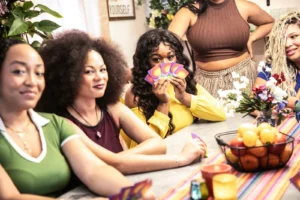
Ntozake Shange’s very personal tale For Colored Girls Who Have Considered Suicide/When the Rainbow is Enuf resonated with one of Nashville’s most acclaimed and brave theater directors, Cynthia Harris, who “continuously creates and performs works that capture the experiences of Black women and girls. Her preferred format is the choreopoem, which she views as a culturally specific form of performance and audience engagement, based on the work of Ntozake Shange, to authentically express the personal and social experience of Black women.”
For this staging, Harris got her inspiration and directorial vision from her childhood memories of her mother and her four aunts sitting around the kitchen table in the late 60s while lending eyes, ears, strength, and wisdom to each other’s struggles. According to Harris, this experience can and should expand beyond blood sisters, into what she calls “sister-friends.” Thus the director not only inherits Shange’s artistic expression through her preferred format of choreopoem, but also the feminist philosophy and approach to life. Interestingly enough, Harris does not borrow the dance aspect, one of the main elements of Shange’s choreopoem, although she endorses the poetic monologues and music. This absence can be read as the director’s darker vision of the condition of black and brown women: united in their voices but not fully liberated through their individual bodily freedoms of expression.
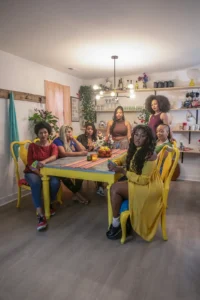 In an Airbnb stage setting (designed by Henry Jones), the walls of which are filled with portraits of powerful and resilient black women, Harris creates a rainbow of “7 sisters reuniting in response to intimate partner violence. Their stories are shared as if they were medicine to each other, helping them to heal together through bringing up their unconditional love and support for each other. These women serve as sacred witnesses to each other’s healing and transformation.”
In an Airbnb stage setting (designed by Henry Jones), the walls of which are filled with portraits of powerful and resilient black women, Harris creates a rainbow of “7 sisters reuniting in response to intimate partner violence. Their stories are shared as if they were medicine to each other, helping them to heal together through bringing up their unconditional love and support for each other. These women serve as sacred witnesses to each other’s healing and transformation.”
The story of the play consists of women, sisters, and sister-friends who, beginning with the youngest one, feel safe to open up and connect on a natural and supernatural level. They transcend through the experiences of mythical heroines and goddesses, all having one thing in common: the beauty and burden of womanhood, the ill treatment, despotism and exploitation that still reigns in a society rendering her as an unequal member. Thus, through any layer of discrimination on the basis of identity politics, it was very easy to feel empathy with the stories that were being unfolded on stage.
In terms of mise-en-scène, every corner of the stage was fully utilized. When one of the women shared her story, the others were attentively listening, surrounding her from various angles. There were also beautiful moments of gathering in smaller groups to converge and connect. Although the performance didn’t directly invite this, the audience was often communicating their empathy, encouragement, and dismay directly, which created a warm homey atmosphere.
Among the actresses, Kristian Hardy as Green especially stood out for her stoic presence in silence, often listening to the other’s stories with full attention. For her last fragment, Nina Hibbler-Webster as Rea took everyone’s breath away.
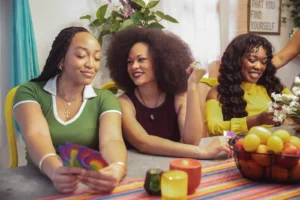 One major hiccup that was a distraction and worked rather against the other elements of the staging was the bad wireless microphone connection which almost sporadically switched between the actresses’ natural and amplified voices. The small theater setting would have functioned without microphones just as well, elevating the intimacy between the performers and the audience.
One major hiccup that was a distraction and worked rather against the other elements of the staging was the bad wireless microphone connection which almost sporadically switched between the actresses’ natural and amplified voices. The small theater setting would have functioned without microphones just as well, elevating the intimacy between the performers and the audience.
During the post premiere talk, in the presence of the seven actresses, Harris spoke of the audition, the rehearsals and of giving space to them to both find their inner voices and connection with their characters, as well as to form a bond with their sister-friends to grow in harmony while embracing their diversities in appearance, style, approaches to life and challenges they face.
By the edge of the blade, both the choreopoem and the staging carried the danger of villainizing all men, particularly the black cis men, until the last monologue where the brutal actions of the perpetrator became related to his loss of sensitivity and the trauma from serving in the army and experiencing the brutality of war, thus raising the issue to a bigger picture, that of the systemic instrumentalization and oppression.
Overall, the performance grew in me as it unfolded the layers of these seven unique women, representing a rainbow, a grain of hope, an aspiration to dream for a better future, only if in that dream we are all equal, while unique and understanding the importance of coexisting as a way of fulfilling one another.
This production’s run is over, but Circle Players’ 75th season continues with And the World Goes Round in the winter. For more information, see Circle Players.
At the Schermerhorn
NSO’s One Program in Three Mediums – Opera, Orchestra, and Ballet
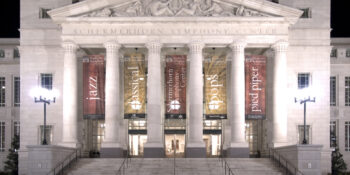
The Nashville Symphony and Maestro Giancarlo Guerrero took audiences to the opera house, the concert hall, and even the ballet with the program presented October 17-19. Featuring the artistry of violin soloist Gil Shaham, this program was situated between a performance the previous weekend of Antonio Vivaldi’s The Four Seasons for Violin and Orchestra, Op. 8, nos. 1-4 and Gloria, R. 589, and a special event accompanying the Tower of Power this upcoming week. Such variety of programming and regular performances are two of the many strengths that have come to be expected of this organization.
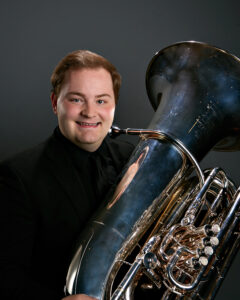
Composed in 1869, the Overture to La forze del destino has cemented itself as a favorite from the pit of opera houses and on stage in concert halls alike. The libretto depicts the consequences of an ill-fated love story, or, in other words, a typical Nineteenth Century opera. A respectfully full house welcomed both Concertmaster Peter Otto and Music Director Guerrero to the stage, after which the opening chords from Giuseppe Verdi’s score quickly sounded.
Perhaps more caffeinated than some interpretations, Guerrero propelled the three opening chords from an impeccably balanced brass and bassoon sections twice, not allowing the first iteration to completely dissipate throughout Laura Turner Concert Hall before inviting the music to continue. Chandler Currier, the new principal tubist and a Middle Tennessee native, is to be credited for playing a cimbasso for this opening piece. With a forward-facing bell and predominantly cylindrical bore, the cimbasso creates a bass sound that can blend with the trombone section even better than can the tuba. Historically, this instrument was commonly used to perform late Romantic Italian opera, so much so that it has even been referred to as the ‘trombone basso Verdi.’
Equally impressive to the robust opening presented by the brass and bassoon sections was the Nashville Symphony’s dynamic range made available throughout Verdi’s score, particularly the softer end of the spectrum. In a society where loud and bold tends to occupy headline real estate, the Nashville Symphony’s willingness to take advantage of opportunities to offer such nuance should be both acknowledged and encouraged.
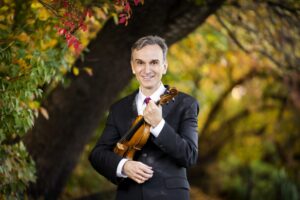
Having just performed Ludwig van Beethoven’s Violin Concerto in D Major, Op. 61 last season, violin soloist Gil Shaham is becoming a perennial highlight for Nashville Symphony audiences. After an extended tuning session backstage, Shaham accepted applause with a humbled grace that seemed to have won him the favor of both members of the Nashville Symphony and its audience – all realities that occurred last season, too. This program featured Mason Bates’ Nomad Concerto, with the added feature of a live recording project expected to be commercially released upon completion.
Along with the Philadelphia Orchestra and San Diego Symphony, the Nashville Symphony is a consortium partner that helped initiate the creation of this work. Receiving its premiere performance with Yannick Nézet-Séguin conducting the Philadelphia Orchestra in January 2024, this piece is the second violin concerto composed by Mason Bates, who offers the following program note:
Nomad Concerto explores the mysterious and soulful music of the wanderer.
Envisioned to showcase the legendary Old World sound of Gil Shaham, the concerto is informed by a diverse range of traveling cultures from Eastern Europe to the Middle East. In the same way that nomadic musics have continually reimagined themselves, the many styles informing the concerto are swirled together into a unique soundworld.
The concerto’s opening movement imagines an old balloon seller wandering through a village as he sings a doleful tune, which is gradually picked up by the villagers. The music draws from a variety of elements of the European Roma, with the soloist sometimes using a strumming pizzicato effect suggestive of mandolin. The movement is followed by the short, scherzo-like ‘magician at the bazaar’ showcasing quicksilver violin figuration that the orchestra transforms into shimmering and gossamer textures.
Over haunting orchestral expanses depicting the vast deserts of the Middle East, the Jewish folk tune “Ani Ma’amin” unfolds in “Desert vision: oasis.” The movement’s heaviness temporarily brightens at the vision of a sparkling oasis. A propulsive finale is animated by the ‘minor swing’ of 1930s jazz clubs, as epitomized by the legendary Django Reinhardt of the ‘manouche’ clan.
Bates has completed residencies with leading orchestral institutions throughout the United State of America – the San Francisco Symphony, National Symphony, and the Chicago Symphony, among others – as well as spinning numerous sets as a dj. All of these influences have been filtered through the composer’s perspective to create a work that, at times, presents quite cinematically, on occasion offers a hip and urban vibe, while still at other times depicts a pastoral expansiveness that calms. Shaham is called to use various string techniques, including a glassy ponticello bowing, as well as bowing while simultaneously using pizzicato with his non-bow hand. Bates’ Nomad Concerto is an intriguing composition that was executed convincingly by both soloist and orchestra. Mason Bates was welcomed to the stage to receive multiple rounds of well-earned applause, before joining the audience to experience the second half of the concert.
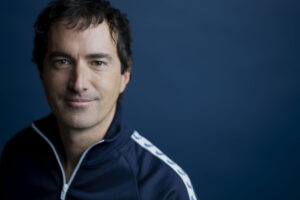
After intermission, Igor Stravinsky’s original 1909-1910 full ballet score for The Firebird completed the program. Lasting about fifty minutes, it is more common for the twenty-two minute Suite from The Firebird to be programmed instead. Offering the entire score affords one the opportunity to hear gestures evolve and the drama they depict to develop and subside. However, without the dance component, sections of the music felt stagnate and unnecessary for the concert hall alone. Furthermore, if dancers were involved, Maestro Guerrero forced tempi that, on occasion, felt frantic and presumably an unfit challenge for choreography.
Regardless, this assumed ‘pet project’ was well received and impeccably performed. Despite many key players of the ensemble executing solo passages with such spirit, or soul as the situation aligned, members of the Nashville Symphony stood together without any individual bows initiated from the podium. Special congratulations should have gone to the woodwind block of the orchestra who brilliantly gave flight to the Firebird, and to principal bassoonist, Julia Harguindey, who offered a “Lullaby” that mesmerized.
Nashville Symphony President and CEO, Alan D. Valentine, needs credit for establishing a culture that welcomes patrons in suits and jeans all the same. Art is often a reflection or a reaction to the context in which it was created. Even without serious study of the medium, music’s power is universal, being felt by academics and amateurs. Nashvillians are urged to open themselves to experience live classical music by an ensemble that has removed many of the barriers once thought to pretentiously protect this magic. Giancarlo Guerrero has built your Nashville Symphony with an artistic prowess that doesn’t need an oceanic coast to prove worthy of receiving accolade or your attention. If you are not patroning the Schermerhorn Symphony Center you are missing out!

